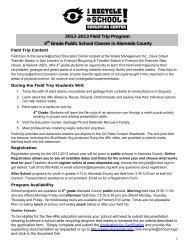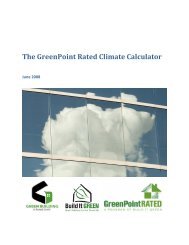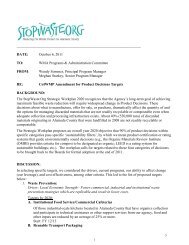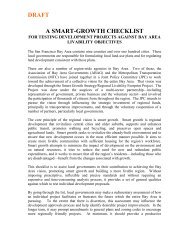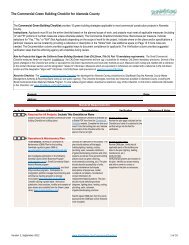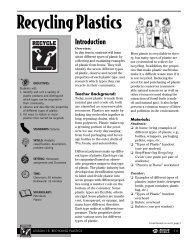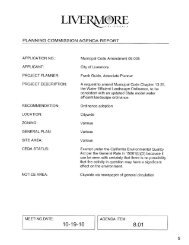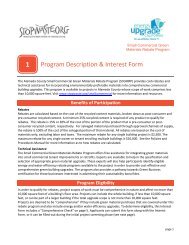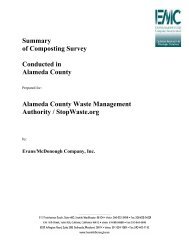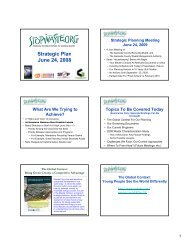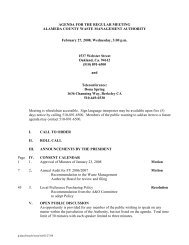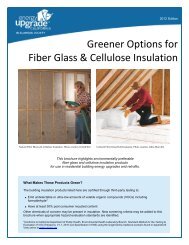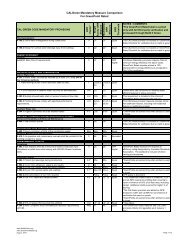Bay-Friendly Landscaping Principles and Practices - StopWaste.org
Bay-Friendly Landscaping Principles and Practices - StopWaste.org
Bay-Friendly Landscaping Principles and Practices - StopWaste.org
Create successful ePaper yourself
Turn your PDF publications into a flip-book with our unique Google optimized e-Paper software.
<strong>Principles</strong><br />
& <strong>Practices</strong><br />
4. Design lighting carefully<br />
Description<br />
Outdoor lighting consumes a large<br />
fraction of the electricity used in the<br />
United States. Site lighting can be<br />
designed to use less energy <strong>and</strong> minimize<br />
light pollution <strong>and</strong> trespass.<br />
Applications<br />
n Identify lighting goals <strong>and</strong> determine<br />
lowest acceptable levels.<br />
n Use only fluorescent, high-intensity<br />
discharge (HID), light emitting diode<br />
(LED), or low pressure sodium lamps.<br />
n Specify Energy Star, photovoltaic or<br />
12-volt for 100% of outdoor building<br />
<strong>and</strong> site fixtures.<br />
n For security, use lights with a photocell<br />
or motion sensor lights instead of all<br />
night illumination.<br />
n Specify that all exterior luminaries emit<br />
no light above horizontal OR are Dark<br />
Sky certified. Visit www.darksky.<strong>org</strong><br />
for a list of fixtures approved by the<br />
International Dark Sky Association.<br />
n Prevent light trespass by selecting <strong>and</strong><br />
placing fixtures that will not spill light<br />
onto neighboring properties.<br />
Benefits<br />
Power <strong>and</strong> energy use can be decreased.<br />
Lower operating costs can often recover<br />
higher initial purchase costs of newer<br />
more efficient lamps.<br />
5. Choose <strong>and</strong> maintain<br />
equipment for fuel<br />
conservation<br />
Description<br />
Equipment is most often selected for its<br />
speed, cost <strong>and</strong> ease of use. However,<br />
reducing fossil fuel consumption is one<br />
of the most important practices the<br />
l<strong>and</strong>scape professional can do to protect<br />
the environment, while lowering the cost<br />
of operating the equipment.<br />
Applications<br />
n Use h<strong>and</strong> powered equipment when<br />
possible <strong>and</strong> take pride in the quality<br />
of the work.<br />
n Minimize the use of gas-powered<br />
blowers.<br />
n When using machinery, choose the<br />
smallest, most fuel efficient, lowest<br />
emission machinery required to get<br />
the job done.<br />
n As you upgrade your equipment &<br />
vehicles, select for fuel economy <strong>and</strong><br />
low emissions. Select vehicles that<br />
operate on biodiesel — or convert<br />
existing vehicles.<br />
n Keep every piece of equipment <strong>and</strong><br />
vehicle tuned.<br />
n Recycle plant debris on site to<br />
minimize fuel consumption for hauling.<br />
n Require employee carpooling to sites<br />
<strong>and</strong> plan maintenance routes carefully.<br />
n Track the gallons of gas your business<br />
consumes <strong>and</strong> set goals to reduce that<br />
consumption.<br />
6. Specify low embodied<br />
energy materials<br />
Description<br />
Embodied energy is the energy<br />
consumed by all the processes associated<br />
with the production of an item, from the<br />
acquistion of natural resources to the<br />
delivery of the final product. The single<br />
most important factor in reducing the<br />
impact of embodied energy is to design<br />
long lived <strong>and</strong> adaptable l<strong>and</strong>scapes.<br />
Transporting items the least distance<br />
reduces fuel consumption <strong>and</strong> air<br />
pollution <strong>and</strong> supports local economies.<br />
Applications<br />
n Consider the source <strong>and</strong> embodied<br />
energy of all materials in the l<strong>and</strong>scape,<br />
including stone, gravel, plants, lumber,<br />
furniture, etc. Use local stone, for<br />
example, rather than limestone<br />
shipped from the Midwest.<br />
n Select smaller container stock to<br />
increase the number of plants per<br />
delivery. Smaller plants also transplant<br />
better.<br />
n Use recycled <strong>and</strong> less highly processed<br />
materials, <strong>and</strong> avoid petroleum-based<br />
products, including synthetic fertilizers.<br />
Benefits<br />
Buying locally produced <strong>and</strong> low<br />
embodied energy products often reduces<br />
the cost of an item, as well as the hidden<br />
environmental costs of transporting<br />
materials, such as pollution.<br />
Benefits<br />
Manual labor may make the most<br />
economic sense for many l<strong>and</strong>scape<br />
operations. You can cut the cost of fuel<br />
while protecting the health of your staff,<br />
<strong>and</strong> local air <strong>and</strong> water quality.<br />
“We use so much fossil fuel that the energy<br />
that is used consumes more oxygen from the atmosphere<br />
than the l<strong>and</strong>scapes actually provide.”<br />
— Bob Perry, L<strong>and</strong>scape Architect, Professor Emeritus, Cal Poly, Pomona<br />
40<br />
3



